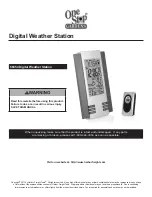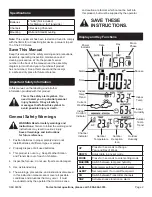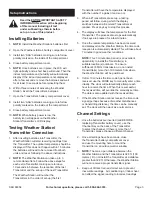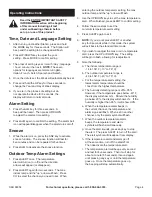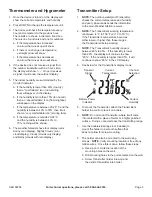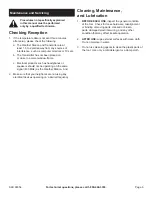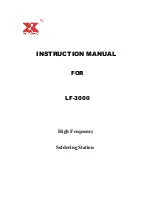
Page 3
For technical questions, please call 1-800-444-3353.
SKU 68354
Setup Instructions
Read the ENTIRE IMPORTANT SAFETY
INFORMATION section at the beginning
of this manual including all text
under subheadings therein before
set up or use of this product.
Installing Batteries
1.
NOTE:
Install the Weather Station’s batteries first.
2. Open the Weather station’s battery compartment cover.
3. Install two “AAA” batteries, making sure to follow
polarity marked on the inside of the compartment.
4. Close battery compartment cover.
5.
NOTE:
Once batteries are in place, the LCD will
light up briefly and a short beep will sound. Then the
indoor temperature and humidity will automatically
display. If the indoor temperature is not displayed
after a few seconds, remove the batteries and wait
for at least 10 seconds before reinserting them.
6. Within three minutes of activating the Weather
Station, insert the Transmitter’s batteries.
7. Open the Transmitter’s battery compartment cover.
8. Install two “AAA” batteries, making sure to follow
polarity marked on the inside of the compartment.
9. Close battery compartment cover.
10.
NOTE:
When battery power is low, the
battery icon will appear on the Weather
Station/Transmitter’s LCD display.
Testing Weather Station/
Transmitter Connection
1. After inserting batteries into Transmitter, the
Weather Station will start receiving readings from
the Transmitter. The outdoor temperature should be
displayed. If this does not happen within 15 minutes,
the batteries will need to be removed from both
units and reset, following the above instructions.
2.
NOTE:
The Weather Station can take up to 3
remote transmitters. Follow the above steps for
each extra Transmitter, making sure to leave
10 seconds in between the reception of the last
Transmitter and the set-up of the next Transmitter.
The Weather Station will number the
Transmitters in the order of set-up (the first
Transmitter will have the temperature displayed
with the number 1 against it and so on).
3. When all Transmitters are set up, a testing
period will follow, during which the display
switches between all received Transmitters at
random. Press any key to stop this process.
4. The display will show the temperature for the first
Transmitter. The process also stops automatically
if no keys are pressed for a few minutes.
5. Once the remote temperature has been received
and displayed on the Weather Station, the time code
reception is automatically started. This will take about
7 minutes in good weather conditions.
NOTE:
This 7-minute time period is an excellent
opportunity to install the Transmitter(s) in
suitable location(s) outdoors. To ensure
sufficient 433 MHz transmission, do not install
Transmitter(s) more than 100 meters from where
the Weather Station will be positioned.
6. If after 10 minutes the time code has not been
received, use the MODE key to manually enter a time
initially. The clock will automatically attempt each
hour to receive the time. When this is successful,
the received time will override the manually set time.
The date is also updated with the received time.
7. If the Weather Station cannot receive the time code
signal (perhaps because of weather disturbances
or transmitting distance), the time can be manually
set. The clock will then work as a normal clock.
Channel Settings
1. Once the batteries are inserted (and BEFORE
replacing Transmitter battery cover), use the
Channel Key on the back of the Transmitter
to select the channel. (If there is more than 1
Transmitter, please choose a different channel.
2. Once all settings have been made, close
the Transmitter battery compartment cover
and use the mounting hole to mount the
Transmitter on an outdoor wall or window.
3.
NOTE:
The max. open distance between the
Weather Station and the Transmitter is 328 ft. (100
meters). Do not install the Transmitter at a distance
greater than 328 ft. Otherwise, the Weather Station
will not a receive a proper transmitter signal.
4. Keep out of direct rain and direct sun to prevent
inaccurate readings. Air conditioning or indoor heat
can effect the signal, leading to incorrect readings.

